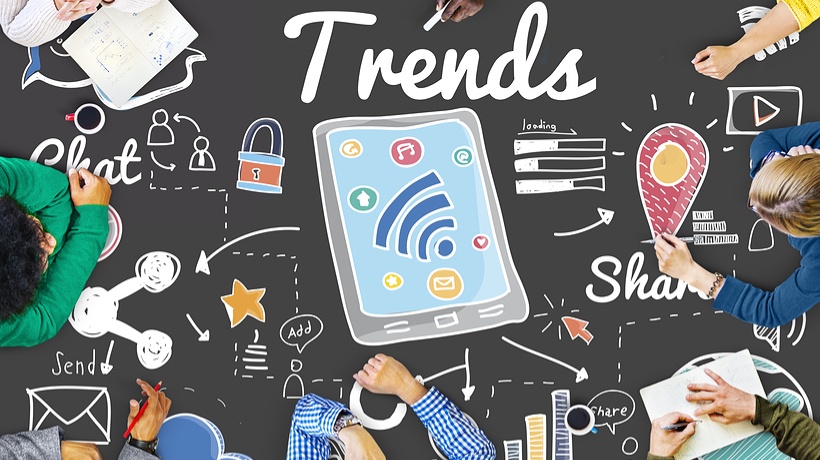The Top Technology Trends Changing eLearning
Currently, the eLearning industry is experiencing a revolution due to the recent advancements in technology. The introduction of new gadgets, innovative tools for trainers, and cutting-edge equipment has allowed us to create new eLearning experiences that we could only dream about a decade ago. According to the Education Sector Factbook, eLearning has grown at a rapid average of 23% per year in the years 2013-2017. The present day’s hottest technological trends play a major role both in influencing eLearning and offering brand new ways to share knowledge and deliver content. Let’s take a look at these emerging technologies, and how they are taking eLearning to the next level.
1. Virtual Reality (VR)
Virtual Reality (VR) is a computer technology that utilizes Virtual Reality headsets or multi-projected environments, sometimes in conjunction with props or physical environments, in order to create realistic sounds, images, and other sensations that promote a user’s physical presence in an imaginary or virtual environment [1].
The functional applicability of Virtual Reality has made it an incredibly popular tech in eLearning. For now, potential applications in the fields of medical training and physics show the most promise. That said, what benefits can this exciting technology bring? First, VR can transmit students to the farthest corners of the universe in just a blink of an eye and surround them with an engaging and deeply educational environment. An improved motivation to learn is another key benefit. Students will no longer be stuck with pages upon pages of boring text, bullet points, and illustrations, but they will have a chance to actually go through the experience and get the most out of it instead. Virtual Reality holds great potential and is expected to go further beyond gaming, to include areas such as training and education, as well as VR films, sports, and music.
To get started with VR in eLearning, a company needs to have a professional developer who can work with software like Unity 3D. In addition, VR headsets are required for the learning populations, which by itself can become a cost-prohibitive factor.
2. Augmented Reality (AR)
Augmented Reality is a technology that superimposes a computer-generated image on a user's view of the real world, thus providing a composite view. This, also, includes real-world sensory input like video, graphics, or sound [2].
When it comes to eLearning, Augmented Reality can make the learning process more interesting and easier to grasp. For instance, if you were an online instructor and your target subject was astronomy, you could offer your students a virtual tour of Mars without asking anyone to leave their home. The concept would also be excellent for research. Experts predict that the AR market could be worth $200 billion by 2024, showing real potential for the future.
Similarly to VR, to start building learning experiences for Augmented Reality, the company needs to have the capability to work with 3D modeling software, and have access to AR headsets for the learners.
3. Artificial Intelligence (AI)
Artificial Intelligence is referred to the intelligence displayed by machines, as opposed to natural intelligence displayed by humans and animals [3]. It is revolutionizing the whole eLearning experience due to the many advantages it has to offer. AI can help highlight areas that require improvement and assist students in focusing on areas where they are lagging. Advanced AI models can solve many problems for the users in a more comprehensive way as compared to the typical classroom curriculum. Furthermore, the technology can also create more realistic experiences compared to traditional linear pre-programmed lessons and eLearning courses.
In order to use AI for training, the company should have access to an eLearning AI engine, and have programmers who can code the learning interactions/experiences.
4. Big Data
According to Christopher Pappas, as stated in the article Big Data in eLearning: The Future of eLearning Industry, Big Data, in terms of the eLearning industry, is the data that is generated by learners while they are taking a training module or an eLearning course. For instance, if an employee is interacting with a training module based around company policies, their progress, social sharing, assessment results, and another relevant date that is being generated throughout the eLearning course is referred to as "big data".
Big Data allows eLearning experts to understand how the users are digesting the information and which learning aspects appeal the most to them. In addition to that, it allows them to pinpoint learning interactions that should be fine-tuned within the eLearning module or course. Based on the learning patterns, eLearning experts can predict where learners may excel or struggle. This way, they can improve their eLearning courses so that the learners get a fair opportunity to accomplish the best possible outcome [4].
Starting with Big Data can be confusing. The company should figure out a way to collect meaningful data, and, once enough data is collected, find ways to process and analyze it to find helpful insights.
5. Machine Learning
Machine Learning is a field of computer science that gives computers the capacity to learn without being directly programmed [5]. There is a range of benefits that Machine Learning can offer to online learners, as well as organizations that invest in LMS platforms. First of all, Machine Learning has the ability to offer more custom eLearning solutions based on the learner’s past performance and learning goals. Secondly, it enables efficient resource allocation since online learners receive the exact eLearning resources they require in order to fill knowledge gaps and accomplish their learning goals.
For a company wishing to start using Machine Learning in eLearning, the main goal should be assembling a team of developers capable to write scripts for Machine Learning.
6. Wearable Devices
Wearable devices also referred to as wearables, are smart electronic devices that can be worn on the body as accessories or implants [6]. These wearable devices can act as versatile corporate training tools since they have the capacity to deliver training experiences virtually anywhere. Wearable devices have the potential to take scenarios and simulations to the next level, which is why they can be used to make learning solutions much more interesting and comprehensible.
To start delivering eLearning on wearable devices, the company should identify learning experiences that are a good fit for wearables, and find ways to integrate eLearning into the daily routines of the staff.
In summary, all the technologies mentioned above can become real game changers for the eLearning industry. They have the capacity to greatly improve the learning experiences for all learners. The companies in the EdTech sector should pay attention to the development of these technologies in order to stay relevant in a rapidly changing market. While getting started with a new technology may be challenging in the beginning, the Internet can provide a variety of useful resources ranging from eLearning case studies to how-to guides and tutorials. Any company should strive to utilize all available resources and technologies to improve the learning experiences and learning outcomes within the organization.
References:
- Virtual reality
- Smart books using Augmented Reality
- Artificial intelligence
- Big Data in eLearning: The Future of eLearning Industry
- What is Machine Learning?
- Wearable technology









